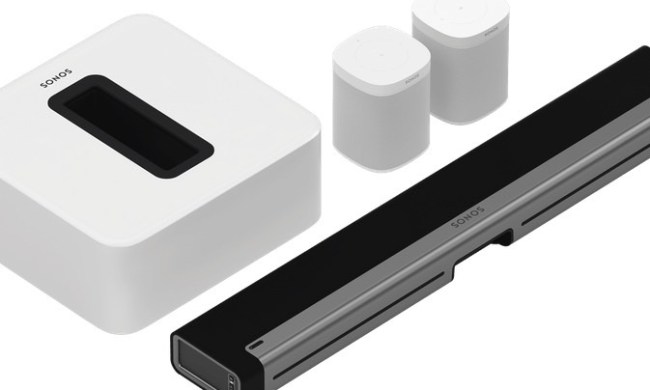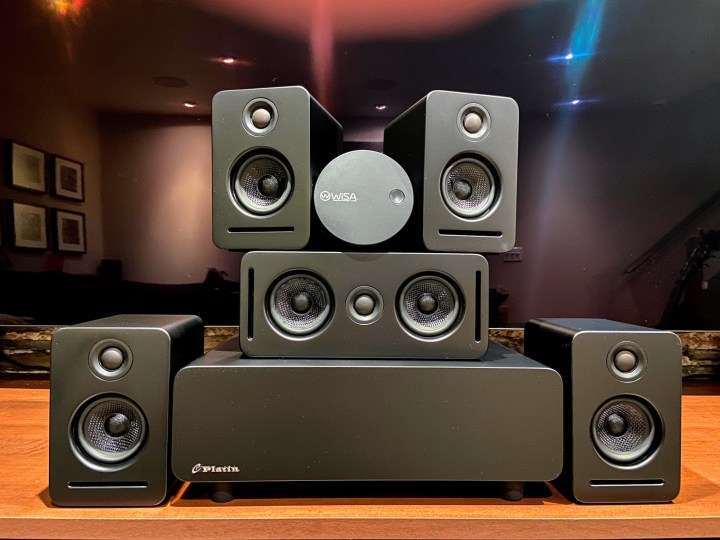
The key to a great home movie experience — beyond finding yourself an awesome TV — is a great sound system. But if you’ve ever looked into buying an A/V receiver and all of the attendant speakers you need to create a 5.1, 7.1, or fancier surround sound system, you’ve likely noticed that it can be an expensive and complicated commitment.
All of those speakers need to be wired to the receiver, which in many cases means hiding speaker wires under carpets or running them through walls or ceiling cavities. For some, it’s a fun DIY challenge, but for most folks, it’s so daunting that they find themselves turning to the next best thing: Soundbars.
Now, soundbars are an awesome solution for getting better TV sound. They’re simple and cost-effective, especially if you go with a single-speaker option like the Bose Smart Soundbar 300, or a soundbar plus wireless subwoofer like the Vizio V21 series. However, these systems won’t provide the kind of fully immersive sound that a dedicated set of wired speakers can provide, which has led many soundbar companies to create models with additional speakers and subwoofers.
Polk’s React Soundbar, with its optional wireless subwoofer and rear surround speakers is a great example, as is the Vizio M-Series.
Some of these systems even have the 3D effect of Dolby Atmos and DTS:X through the use of up-firing height channel speakers — though this can easily send the price of a soundbar system soaring well over $1,000.
But what none of these soundbars offer is a true replacement for a wired, discrete speaker system. They don’t let you place the left, right, and center channel speakers in specific locations, and most don’t use a truly matched set of speakers for surround channels.
Moreover, with very few exceptions, they don’t give you the freedom of being able to swap out any of their components as your needs, your room, or your budget changes over time.
WiSA, the wireless speaker cable
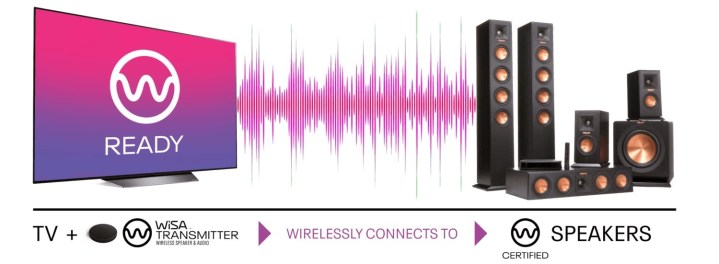
Fortunately, there’s a third option. WiSA, which stands for the Wireless Speaker and Audio Association, is a technology that eliminates traditional speaker cables with a lossless, hi-res wireless connection. Unlike Wi-Fi or Bluetooth, WiSA is strictly for single-room, hi-fi applications — and a growing number of speaker and TV companies like LG, Klipsch, and Bang & Olufsen are creating products that work with WiSA.
There are two main components to a WiSA system: A WiSA compatible speaker(s) and a WiSA wireless transmitter.
Instead of doing a deep dive into WiSA in this article, I encourage you to read our in-depth WiSA explainer. It’s got everything you need to know about how WiSA works, and what you need to set up your own WiSA-based home theater sound system.
What that explainer doesn’t discuss is what it’s actually like to set up and use a WiSA system, which is probably why you’re here. Let’s get into it.
The WiSA experience
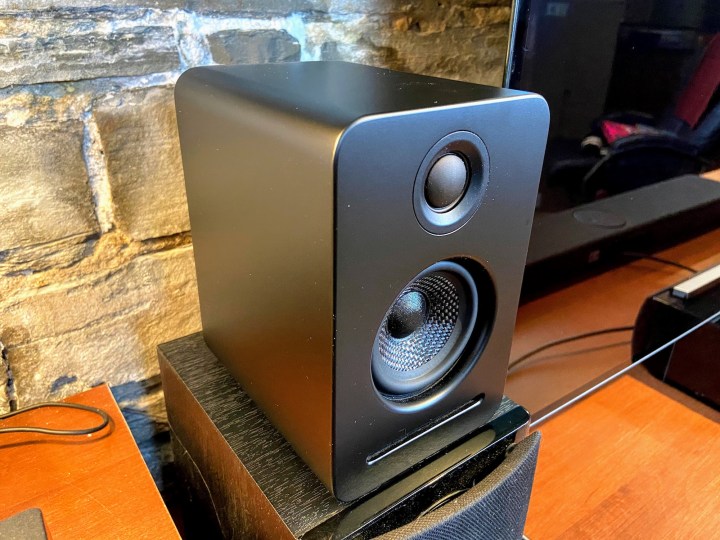
To get a sense of what it’s like to use a WiSA system, the association loaned Digital Trends a $999 Tuned by THX Platin Audio Monaco 5.1 Immersive Wireless Home Audio System speaker package. It contains a matched set of four speakers for front and surround left/right channels, a center channel speaker, and a subwoofer.
The real secret sauce, though, is the included WiSA SoundSend. It’s a small, black hockey puck that acts as a hybrid of an A/V receiver and wireless transmitter to grab the audio output from your TV and send it over the air to the six wireless speakers.
As long as you have power outlets within six feet of your desired locations, all you need to do is plug the speakers in, then plug the SoundSend into power and your TV (via HDMI ARC or an optical cable), and you’re pretty much done.
In our case, the Monaco speakers were prelabeled with their positions (front right, front left, surround left, etc.), but with other WiSA speakers, you can assign positions as you see fit within the WiSA SoundSend app, which we’ll discuss next.
Lots of control, but no remote
WiSA systems, generally speaking, don’t come with their own remote controls, which may be a tad confusing. Instead, they’re intended to be controlled by your TV’s remote control. If your TV happens to be a WiSA-ready TV, like LG’s 2021 OLED and NanoCell TVs, all of the speaker settings are accessible from on-screen menus.
The WiSA SoundSend feature included with our loaner Monaco system can also be controlled by your TV’s remote (if you connect it to your TV via HDMI ARC). But because the SoundSend is designed to work with any TV, not just WiSA-ready models, you need to use the SoundSend app for iOS or Android to adjust the system’s settings.
The app is easy and intuitive, with all of the various settings distributed across four tabs: Speaker Trim, Speaker Settings, Audio Settings, and Advanced Settings.
It functions as a simplified version of an A/V receiver. You can fine-tune the sound by indicating your distance from each speaker and your chosen speaker locations. If the resulting sound is still not quite right, the app gives you level adjustments for each speaker. That’s helpful for boosting the volume of, say, the center channel, if you’re having trouble hearing dialogue, or for the surround speakers if they’re positioned too close to your listening area and you need to bring them down a notch.
There are also several ways to work with the system’s EQ, including a sound sync adjustment in case the on-screen speech doesn’t match up with what you’re hearing; several EQ presets like Movie, Sports, Night, etc., that emphasize different frequencies; and a full five-band EQ for when you want granular control of the sound.
One thing you can’t control: Crossover frequencies. The SoundSend automatically polls the connected WiSA speakers and adjusts the crossovers to match their stated capabilities.
After setting up the Monaco speakers, it was a breeze to tweak their settings in the app, and the SoundSend responded to volume and mute commands from our TV’s remote.
The one thing I would like to see WiSA add is a room calibration feature. Several soundbar models and most A/V receivers come with an accessory microphone that can be positioned near the viewing area. The system will run some automated sound checks and use the mic to determine what should change based on your room’s acoustics.
In an ideal world, WiSA would use the mic built into your smartphone for this function, much like Sonos does with its Trueplay room-tuning feature.
This is true 5.1 sound
My normal home theater setup is a fully wired, 5.1.2 system that’s a mix of Energy and Monitor Audio speakers powered by a Pioneer A/V receiver. Coincidentally, the center channel and satellites provided in the Monaco 5.1 system are a fairly close match in terms of size and design.
With the exception of the Monaco subwoofer, which struggled to output the same furniture-shaking low-end that my Energy sub can produce, the two systems performed very evenly.
The tonal balance of the Monaco speakers out of the box is pleasingly neutral, with no undue emphasis on highs or lows. When watching movies, speech is crystal clear, and surround sound effects are placed with precision. Some of my favorite action titles from the last decade, like Marvel’s Avengers: Endgame, John Wick 2, and Mad Max: Fury Road are an absolute treat, even if the subwoofer’s low-frequency effects are more subtle than I’m used to.
I’ve reviewed some very good soundbars, like the $800 Sonos Arc and the $800 Bose Soundbar 700, and each can create an impressively immersive soundstage. But there’s just no substitute for having a set of dedicated, matched surround speakers pointed at your head from either side of the couch.
The combination of a dedicated center channel with four, full-range speakers lets the Monaco eliminate much of the directional sound that can often be the byproduct of having a single bar of drivers in front of the listening space. Instead, the Monaco — like all good dedicated 5.1 systems — turns sound into something that moves fluidly all around you. And it’s just as enjoyable for music as it is for movies. But, as we’ll see below, it’s not always easy to get the music you want.
The WiSA wireless connection worked perfectly the entire time I was using the system, with no hint of dropouts or sync issues.
Mostly movies
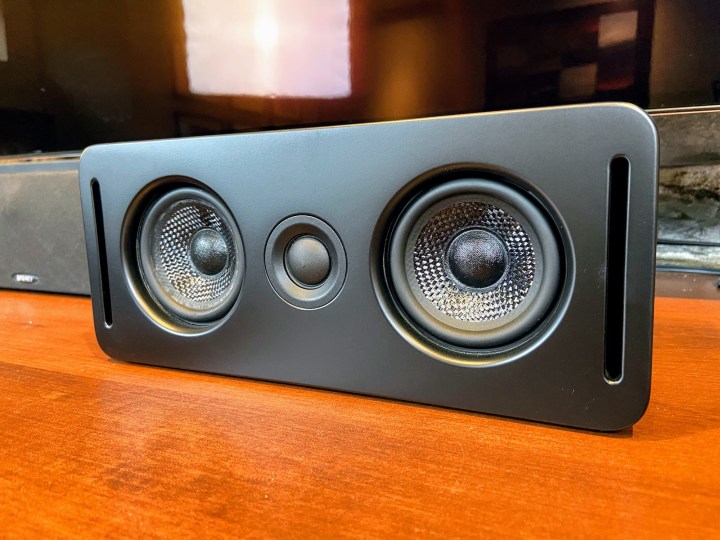
A WiSA speaker system like the Audio Monaco 5.1 is a cinch to set up and use. But it quickly becomes apparent that the WiSA SoundSend is mostly for TV-based audio and not other sources like Bluetooth, Chromecast, AirPlay, or hardware like CD players.
You can connect a second device to the SoundSend via the optical port if you’re using HDMI ARC for your TV, but the only way to switch between these two sources is with the SoundSend app.
WiSA believes that since most new smart TVs have apps for streaming music services like Spotify and Apple Music, you’ll use your TV to listen to music, too. WiSA applies the same principle to wireless streaming from your other devices: Your TV is expected to support Bluetooth, AirPlay, and Chromecast.
This creates a problem for owners of older TVs. Our test TV, for example, is an LG C7 4K OLED TV. It doesn’t support AirPlay or Chromecast and its WebOS software doesn’t have apps for Apple Music, Tidal, or YouTube Music.
The TV also lacks support for HDMI eARC, so even though the SoundSend is compatible with lossless audio formats like Dolby TrueHD, there’s no way to send that format to the SoundSend (HDMI ARC only supports lossy formats like Dolby Digital Plus).
In theory, you could get around this problem by using an HDMI switcher. If you wanted to use a UHD Blu-ray player as a source of Dolby TrueHD, you could plug it into the HDMI switcher and send that signal to the SoundSend. But that creates a somewhat convoluted setup.
Your Blu-Ray player would have to support two HDMI outs (one for audio and video, and one just for audio), and you would have to wire one of those to a TV HDMI input and the other to the HDMI switcher.
Then to make it all work, you’d need to set your TV to the right HDMI input and set the HDMI switcher to the right input. This may or may not be something you can accomplish with a single remote. It kind of defeats the purpose of a simple setup that WiSA enables.
In fairness, the WiSA SoundSend is just one of many WiSA wireless transmitters. The $1,199 Axiim Q UHD Wireless Media Center is much closer to a true A/V receiver, with multiple HDMI inputs and a 4K, HDR-compatible HDMI output, but it’s very expensive for what you get.
Almost awesome
So where does this leave us?
WiSA-enabled speakers are easy to set up — especially if they come prepackaged like the Platin Audio Monaco 5.1 — just as easy in fact, as setting up a soundbar.
The WiSA SoundSend is also incredibly easy to use as the go-between from your TV to the wireless speakers.
But the SoundSend’s design places the full burden of media playback on your TV, which may not be able to deliver the streaming apps you want. Adding a streaming media device to your setup, like a Chromecast with Google TV, will give you most of the apps (and wireless streaming) that your TV may lack, but it can’t overcome an older TV’s lack of HDMI eARC.
This solution also means you’ll need your TV turned on even if you just want to listen to streaming music, something that not everyone will like.
Still, if you’re mostly looking for an alternative to wiring up home theater speakers for your TV, the WiSA ecosystem makes a ton of sense. Each wireless speaker and even the SoundSend itself can be swapped out with newer components over time, giving you a choice: A one-time, easy investment, or a fully modular system that lets you mix and match to get the ultimate in customized sound.









